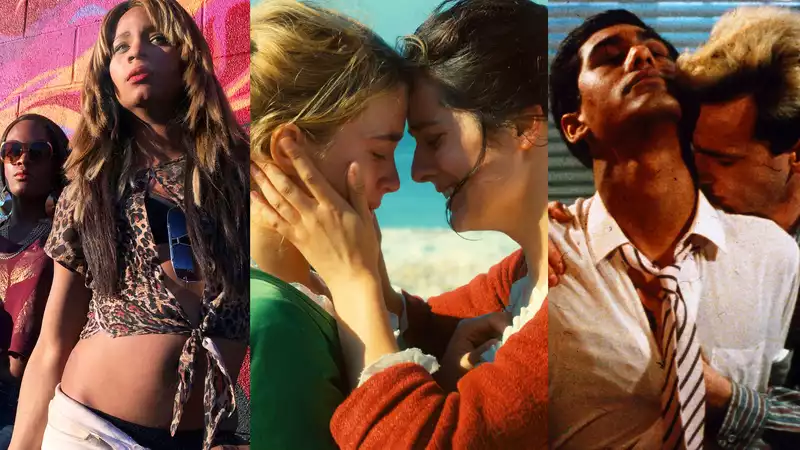
The best LGBTQ+ film ever made
Appropriate representation on screen is fundamental to understanding ourselves, especially as we grow up. LGBTQ+ representation in film (opens in new tab) has expanded and evolved from stereotypes and archetypes to more fleshed out characters, especially in the late 20th and early 21st centuries. The history of queer cinema (open in new tab) is long and often acrimonious, with some early masterpieces such as "The Rocky Horror Show" and John Waters, and many bad films (see "Ace Ventura" (open in new tab)). But many daring artists have explored identity and expression (opens in new tab) in myriad fascinating and beautiful ways in fictional and non-fictional spaces.
So without further ado, here are my own personal picks for the best LGBTQ+ films over the past 30+ years. If you'd like to read more, you can find comprehensive lists here (opens in a new tab) and here (opens in a new tab) (film and TV critic Alonso Duralde is particularly insightful on the topic). There are many to like and many to choose from, but here's a good place to start.
WATCH IT (opens in new tab)
A twist on a twist. Centering on a con artist who attempts to steal the inheritance of a wealthy heiress on the Japanese-occupied Korean peninsula, anything can happen. Eroticism and sadism abound among the characters, with various explicit scenes. But at the heart of it all is the budding relationship between two women, the healthiest one in the entire situation. [Transgender sex workers Sin-Dee Lela and Alexandra cross Los Angeles in search of Sin-Dee's fling and pimp. With trans actresses of color Kitana Kiki Rodriguez and Mya Taylor playing trans women of color on screen, the film resists the tired old trope of the "hooker with a heart of gold (opens with a new tab)." This is not a perfect film. While it undoubtedly falls prey to the violence and subjugation (open in new tab) of its subjects, it is one of the few recent films ("Fantastic Women" (open in new tab), "Pariah" (open in new tab)) to center and prioritize marginalized communities that are not often seen on screen is one of them. [A mobster's girlfriend meets her ex-con neighbor, who basically seduces her and draws her into a plan to steal millions of dollars from the mob and start a new life. This '(opens in new tab) 90s film (opens in new tab), the directorial debut of the Wachowski sisters, is a forward-thinking crime thriller for its time, centered around two women, thanks to the intimacy consultants on the set. Violent and very neo-noir, the film is clearly rooting for the women and their dreams of starting over together.
WATCH IT (open in new tab)
The film received a lot of critical love, including an Oscar for Best Picture, and rightly so. But that attention obscured the story's hyper-specificity: a poor black boy who grows up feeling unsafe in exploring and accepting homosexuality. The film addresses the three profound moments of tenderness (surrounded by violence and pain) that make him who he is. That this story is not often seen on screen speaks to the need for this film and others like it, but it is also a shocking gut-punch, with a glimmer of hope at the end (opens in a new tab).
WATCH IT (opens in new tab)
A woman secretly hired to paint a portrait of a wealthy woman refuses to sit for the portrait to be sent to her future husband. They stare at each other for a long time (incredibly quiet, but very sexy, this film) and begin an affair. Spoiler alert: Like many queer films, this couple can't get together (which makes sense, since the film is set in the 18th century), so it's a story of longing and heartbreak. But every moment is gorgeous.
WATCH IT (opens in new tab)
Amidst the racism, classism, and violence of 1980s London, the relationship between a Pakistani man from a socially conservative family and a former fascist (played by future acting icon Daniel Day-Lewis) . Their relationship is not portrayed in an obscene manner, but focuses on the day-to-day moments of intimacy as they forge a secret bond. It is an older film, but it also dares to show the two main characters taking countless blows, both literally and figuratively, but still happy and hopeful in the end.
WATCH IT (opens in new tab)
There are so many great LGBTQ+ documentaries ("How to Survive a Plague," "The Times of Harvey Milk") that it is hard to pick one. But this award-winning film is a brilliant portrait of New York ball culture and the wide range of presentations, identities, and races in the community. It is also an examination of the AIDS crisis and the deep homophobia that existed during the 1980s and 1990s. The spirit lives on today, including reality shows like "RuPaul's Drag Race" and "Legendary" (opens in new tab), which captures the "golden age" (opens in new tab) of drag balls (opens in new tab).
WATCH IT (opens in new tab)
It's a simple rom-com, but that simplicity works in its favor. Simon Speer is gay, but he hasn't come out to his friends or family. One of his classmates (who?) is also gay, and the two connect online. The drama surrounding the teen is sweet and dramatic, but none of the characters are in mortal danger (opens in a new tab). Mitchells vs. Machines and Booksmart also feature teenagers who live happy, healthy lives as they are, although this may be misleading."
.
Comments